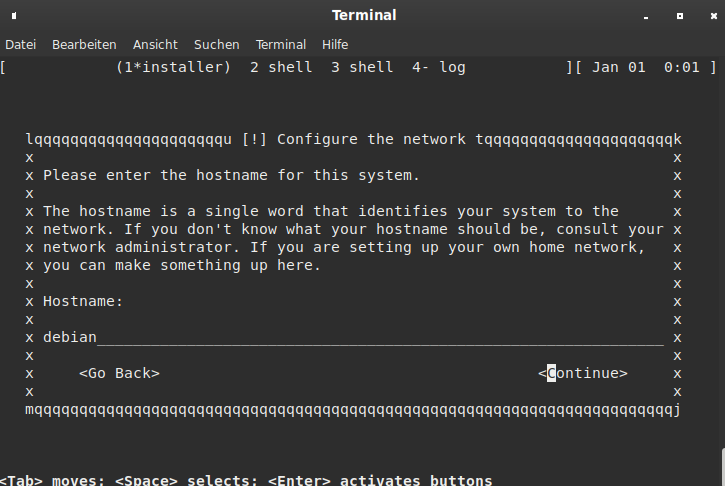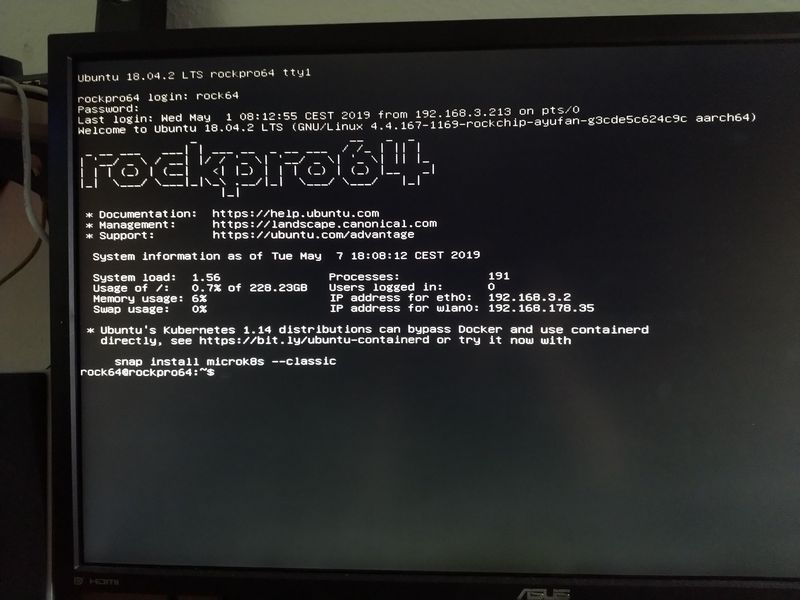Rockpro64: Boot von SSD statt SD(bootloader)
-
Hallo Leute,
ich habe Rockpro64 SBC und wollte ich NAS setup mit openmediavault aufbauen.
Mein Ziel : boot von SSD statt sd karte.
ich habe schon Marvell88SE9128 pci-e chip mit zwei SSD verbunden.
Die Zwei SSD ist in RAID 1 Konfiguration.
Jetzt wollte ich gern die Boot von SSD machen. ich habe schon ein partition innerhalb SSD erstellt. Aber ich weiß nicht wie kann ich machen.
Können Sie mir helfen?
ich habe schon die folgende artikel gelesen. aber ich weiß nicht, wie kann ich OMV von SSD (partition-1) booten. wie sollte ich die konfiguration ändern? ich habe ein paar video rasperry pi 4 boot von SSD angeschaut. aber das ist ganz anders wie OMV(Rockpro64)
https://forum.frank-mankel.org/topic/747/sata-booten-jetzt-möglich
https://forum.frank-mankel.org/topic/609/rockpro64-booten-von-usb3Vielen Dank.
PS: ich bin nicht deutsch muttersprachler.
-
Update: ich habe diese post gefunden und habe versucht
(https://forum.frank-mankel.org/topic/208/booten-von-der-nvme-platte)Leider könnte ich nicht booten. es gibt ein fehler. ich habe LVM benützt um ein partition zuerstellen. Dann habe ich alle root folders/files kopiert. Aber das ist nicht geklappt.
Hat jemand eine Lösung finden?
-
Hallo,
die RAID1 Konfiguration müsste ein bootbares System enthalten, damit der u-boot von dort bootet.
Dazu muss dann der u-boot im SPI Speicher sein.- u-boot im SPI ?
- Bootbares System auf dem RAID1 ?
Alternativ, könnte man ein vorhandenes OMV-Image auf eine SD_Karte schreiben und die Daten auf dem RAID1 ablegen.
Die Frage ist wie immer, was möchte man erreichen.
-
@FrankM sagte in Rockpro64: Boot von SSD statt SD(bootloader):
die RAID1 Konfiguration müsste ein bootbares System enthalten, damit der u-boot von dort bootet.
In welche file kann ich ändern oder meinst du der U-boot im SPI?sollte ich mit diese quelle (https://github.com/sigmaris/u-boot/wiki/Flashing-U-Boot-to-SPI) weitermachen?
VG,
Siva -
So, If I boot from SSD using U-boot-spi, then I can't use my SSD to save other files I think. because entire disk will occupying the OS if I enlarge it. I just want to create a partition for OS and boot the OS only from that and the remaining part of the disk, I would like to use it for user storage or docker config/container files.
I would like to have the OS boot in raid 1 setup.Another thing is, Normally once I flash the OMV to my sd card. I need to add pci=nomsi and marvel-99.rules to make my PCI available to use ssd drives.
How will I boot from SSD after flashing the U-boot-to-SPI? I dont think the rockpro64 boots from ssd.
I looked into this post: https://forum.frank-mankel.org/topic/735/nvme-booten-jetzt-möglich/7
Maybe should I copy the os into the partition which I already have in raid 1 setup using DD command and will it boot from the partition?
I am afraid, i dont wanna mess it up with SPI-boot. I dont have any serial controller to see the error message and not sure how would make it back to boot from sd if something goes wrong.
Since I am using differnt PCI-e. Not sure how to enable it and make it boot from ssd after this u-boot-spi thing?
Please let me know.
Thanks.PS: you can write me in german. Its totally fine.
-
Wo fang ich an?
Für deine Partitionsprobleme mit OMV musst du bitte woanders suchen. Ich nutze kein OMV und setze meine ROCKPro64 auch anders ein.
Die Marvel SATA Karte ist etwas eigenwillig
 Einer der Gründe, warum ich die Karte nicht mehr in meinem NAS einsetze. Link
Einer der Gründe, warum ich die Karte nicht mehr in meinem NAS einsetze. LinkDiese Karte bootet übrigens kein Betriebssystem von einer angeschlossenen SSD / HDD.
Was geht, kann man hier nachlesen. Ich fasse mal zusammen.
OHNE U-BOOT IM SPI
- SD-Karte JA
- eMMC (kann ich nicht mehr testen)
MIT U-BOOT IM SPI
- USB2 JA
- USB3 NEIN
- PCIe NVMe SSD JA
- PCIe SATA JMS-585 JA
Um von einem Laufwerk zu booten, muss auf diesem auch ein Betriebssystem drauf sein, von dem man starten kann. Ich nutze fast ausschließlich dieses Image.
Man kann den SPI abschalten. Dazu brückt man die Kontakte 23 & 25
https://wiki.pine64.org/index.php?title=ROCKPro64#Disable_SPI_.28while_booting.29Das hatte ich schon mal zur Marvel Karte geschrieben.
Aber auch hiermit ist ein Boot von der SATA Platte nicht möglich. Ich möchte hier noch was vom kamil zitieren. (11:44:09) ayufanWithPM: will look later, but this controller is tricky, also on x86 as well (11:44:16) ayufanWithPM: jms585 seems to be significantly more stable Evt. bekommt er das gefixtIch hoffe du kommst jetzt damit klar. Brücken auf dem Board, sollte man nur dann machen, wenn man genau weiß was man macht! Für Schäden übernehme ich keine Haftung. Bitte vorher das Gehirn einschalten.
Ich hoffe, das die Infos noch aktuell sind, ein kurzer Test eben, brachte nix Neues.
P.S: Mein NAS läuft seit Monaten stabil

-
Hallo Frank,
danke für die infos.ich habe https://github.com/ayufan-rock64/linux-build/releases/download/0.10.12/buster-minimal-rockpro64-0.10.12-1184-arm64.img.xz image benützt.
Leider könnte ich Ip addrese nicht bekommen. DHCP is schon eth0.yaml (True) und kein internet.
eth0 port 1GB ist schon drin. (UP link enabled)
Ich weiß nicht was passiert
-
So I was trying to install Armbian based image (Raspian Buster). After installing, I have to manually enable the network
using the following command and then I got the IP address.
sudo nmtuiThen I have enabled by marvel Pci-e by adding a rule in /udev/ and also added pci=nomsi in kernal boot parameters. But my SSD drives dint show up.
Anything you could recommend inorder to solve this issue?
Thanks
-
I have tried the same image which you posted above. 0.10.12-1184-arm64.img.
I could see my eth 1Gb shows up. But there is no static IP set. I followed this guide https://forum.frank-mankel.org/topic/211/die-ersten-schritte-nach-der-installation
to setup after that.But I can't able to get the IP nor the internet.
Could you please suggest me something which I can use to solve this issue.
Thanks. -
Das Image ist ein Debian. Das zieht ganz normal per DHCP eine Adresse. Das sollte auch bei Dir so funktionieren. Es sei denn, bei dir läuft kein DHCP-Server!?
Netplan benutzen die bei Ubuntu, das steht auch in dem Artikel so drin. Bitte fang mal mit den Basics an, danach dann PCIe usw.
-
Yeah it should pull dhcp address automatically. But it dint. It was working when I use Armbian image or OMV (stretch-openmediavault-rockpro64-0.8.3-1141-armhf.img). It automatically pulled the ip address. Only for this distro. It doesn't work.
I use pfsense as firewall and dhcp is set for all my ports. i dont understand why it doesn't work for this.
One thing I notices is eth0 Link is UP - 1Gbps/full. It is the first time I am seeing this on the command line.
Before that it used to be eth0 Link is up - 10/100 mbps..
-
update: I used the cat 6e cable which is capable of delivering 1 gbps and it worked. Isn't it strange?
the normal rj45 cable doesn't work. Now dhcp gave the address and everything looks fine.
Do you think this is a stable version? Can It be use for a homeserver? Because in the github it mentioned as testing purpose and not stable.
Thanks
-
Nice workaround

I am only using this image. My NAS is running since months with an PCIe SATA Card JMS585.
Two Raid 1 and an SSD for system.
https://forum.frank-mankel.org/topic/789/rockpro64-pcie-sata-karte-mit-jmicron-jms585-chip/13

